Netherlands-South African Railway Company
| Overview | |
|---|---|
| Main region(s) | Southern Africa |
| Stations called at |
From Pretoria - Lourenço Marques to Pretoria - Johannesburg Company |
| Listed Company | |
| Headquarters | Amsterdam, Netherlands and Pretoria, South Africa |
Number of employees | ca. 1500 Dutch employees; an unknown number of South African employees |
| Founded | 1887 |
| Defunct | 1902 |
| Successor | Central South African Railways |
| Technical | |
| Track length | ca. 1147 km |
| Gauge | 1,067 mm (3 ft 6 in) |
The Netherlands-South African Railway Company (Nederlandsche Zuid-Afrikaansche Spoorwegmaatschappij) or NZASM (also sometimes called ZASM in South Africa) was a railway company established in 1887. The company was based in Amsterdam and Pretoria, and operated in the South African Republic (ZAR) during the late 19th century. At the request of ZAR president Paul Kruger, the NZASM constructed a railway line between Pretoria and Lourenço Marques in Portuguese East Africa (now Maputo in Mozambique).
Background
The British conquered the then Dutch Cape Colony in 1806. The new administration was not universally accepted by the Dutch colonists and after the 1830s thousands of Dutch-speaking colonists (called Boers) migrated to the interior of Southern Africa. This migration, known as the Great Trek, resulted in the establishment of 14 independent republics. By the mid 19th century these republics had merged into the two larger republics: The South African Republic (ZAR) and the Republic of the Orange Free State. The British Empire eventually recognized the independence of these republics in 1852 and 1854.
The relationship between the British and the Boers remained strained throughout the 19th century, especially as a result of the First Boer War (1880–81). Both republics were located in the interior of what is now South Africa, with no route to the coast that did not pass through the British-held Cape Colony and Colony of Natal. Paul Kruger, president of the ZAR, decided that an alternative trade route to the ocean was a priority for the ZAR. The Witwatersrand Gold Rush after 1886 resulted in the rapid industrialization of the ZAR, making access to the ocean even more important, and allowed the suddenly cash-flush republic to invest in large-scale infrastructure projects.
It will set an indelible seal upon the freedom, the independence, the nationality of the Republics, and will put an effectual barrier on the extension of British dominion over the Vaal and Orange Rivers, it will make it perfectly immaterial to us whether the Liberals or Conservatives in England, or Molteno or Patterson at the Cape, are in power.
— Free State Express, quoted in James Stanley Little, South Africa: A Sketchbook of Men, Manners and Facts (1887) Swan, Sonnenschein, Lowrey & Co. London. p.266.
Establishment
In 1874 the Volksraad of the ZAR decided that a railway would be built connecting the ZAR with Lourenço Marques on Delagoa Bay in Portuguese East Africa (now Maputo in Mozambique). A commission was established in 1874 to create a plan for the construction of this railway. After initial success in raising capital and acquiring a railway concession from the Portuguese government, the project was stalled by the outbreak of the First Boer War. After the end of the war in 1881 the project was resumed, this time with renewed enthusiasm due to the threat of British domination over the Boer Republics. In 1884 a concession was granted to a group of Dutch investors, and this was followed by the official establishment of the Netherlands-South African Railway Company on 21 June 1887 in Amsterdam in the Netherlands, funded by Dutch, German, and Boer investors.[1][2][3]
The Pretoria - Delagoa Bay line, with a length of 562 kilometres (ca. 350 miles), was opened on 6 November 1894 and is still in use today. The railway company employed about 3000 people. Of these, about 1500 were employed in the construction of the Pretoria - Delagoa Bay Line. It adopted the 3 ft 6 in (1,067 mm) (Cape Gauge) of the neighbouring Cape Government Railways.
On 19 February 1896, a train loaded with dynamite was struck by a shunter while being unloaded. The resulting Braamfontein Explosion was one of the largest artificial non-nuclear explosions in history, resulting in more than 70 deaths and 200 injuries.
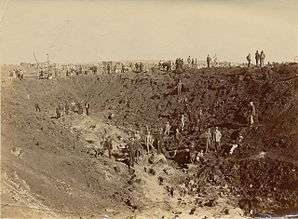
In 1897, a new station was constructed in Johannesburg. The building was constructed in 1895 in Rotterdam and was used in the Amsterdam Exhibition before being dismantled and shipped to Johannesburg, where it was rebuilt in 1897. Although Johannesburg Park Station has twice been reconstructed, the 1897 building was preserved and moved a short distance to Newtown where it still stands, unused, today.
By 1899, the NZASM had constructed 1147 kilometres (ca. 712 miles) of railway.[1]
The Randtram Line
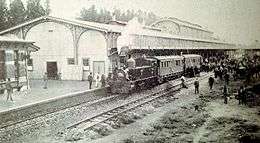
As a result of the rapid development of the goldfields on the Witwatersrand in the 1880s and the demand for coal by the growing industry, on 20 July 1888 the ZAR government granted a concession to the NZASM to construct a 16 miles (26 kilometres) railway line from Johannesburg to Boksburg. The line was opened on 17 March 1890, with the first train being hauled by a 14 Tonner locomotive. It became known as the "Randtram", even though it was actually a railway in every aspect and not singularly dedicated to tram traffic. This was the first working railway line in the Transvaal.[4][5][6][7]
The concession was extended the following year to continue the line eastward to Springs, where coal was known to exist, and westward via Roodepoort to Krugersdorp. The entire 49-mile (79-kilometre) line was opened to traffic on 10 February 1891.[4][5]
In 1889 and 1890, the NZASM obtained three tramway steam locomotives with an 0-4-0T wheel arrangement for use on the Randtram line. Since the railway classified its locomotives according to their weight, these tank locomotives were known as the 10 Tonners.[4][5] As the Randtram line was expanded to the west and east to become the Reef line between Roodepoort and Springs, the 14 Tonners remained in service on that line, even though their range of operation was somewhat limited by their small coal and water carrying capacities.[4][5] The first locomotive, No. 1, named Transvaal, entered service on 18 July 1889. It hauled the first train on the Randtram line when it was opened on 17 March 1890, and was retired in December 1903, by which time it had covered a distance of 113,309 miles (182,353 kilometres).[4]
By 1899 the Randtram Line had expanded to a length of 82 kilometres (ca. 51 miles).[1]
Pretoria–Delagoa Bay Line (Oosterlijn)
In order to have an outlet to a harbour, a railway line from Delagoa Bay in Portuguese East Africa to Pretoria had been proposed to the Volksraad of the ZAR by President F.T. Burgers as far back as 1872. The Portuguese supported the idea, since it would open a trade route from Portuguese East Africa into the interior. In 1883, Major Joachim Machado was sent to the Transvaal to report on a proposed route through the Komati River and Crocodile River valleys towards the Highveld and Pretoria. The resulting agreement was for the Portuguese to construct the section from Delagoa Bay to the border at Komatipoort, while the ZAR would be responsible for the continuation of the line to Pretoria.[5][6]
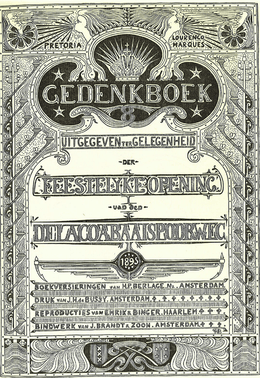
The Portuguese line from Delagoa Bay had already reached the border on 14 December 1887, but the first train from Delagoa Bay only entered Komatipoort on 1 July 1891, when the NZASM's contractors completed the bridge across the Komati River. The line from Komatipoort to Nelspruit was completed by 20 June 1892. Waterval Boven was reached on 20 June 1894 and Balmoral, near Witbank, on 20 October 1894, connecting with the line which had simultaneously been built eastwards from Pretoria.[5][6]
The construction of the railway line from Delagoa Bay to Pretoria was beset with difficulties, both in terms of disease and engineering. Malaria claimed many lives among the construction crews, and some of the terrain was mountainous. In the Elandspruit Valley, where the river formed a 295-foot-high (90 m) waterfall, the adjacent cliffs presented a natural barrier to the continuation of the railway from the Eastern Transvaal Lowveld up to the Transvaal Highveld.[4][8]
In terms of construction, the climb up the escarpment was arguably the most difficult section to be encountered by the railway builders on the route. When the line reached Waterval Onder, they had a choice between a lengthy detour with sharp curves and costly deep cuttings, embankments and viaducts, to comply with the agreed upon gradient of 1 in 50 (2%), or a shorter 4 1⁄2-mile-long (7.2 km) section, which would entail a gradient of 1 in 20 (5%) over a distance of 2.1 miles (3.4 kilometres) in one place, as well as a 233-yard-long (213 m) tunnel.[4][8]
The shorter and steeper route was selected. While a gradient of 1 in 20 (5%) is not insurmountable by light trains with orthodox adhesion locomotives, safety and economical considerations led to the decision to install a rack track on the section up the escarpment between Waterval Onder and Waterval Boven. The rack track was built to the Riggenbach system which was in use on European mountain railways, with the rack laid between the rails.[4][8]
The line, also known as the Oosterlijn (East Line) from Pretoria to Lourenço Marques had a total length of 562 kilometres (ca. 350 miles), of which 472 kilometres (ca. 293 miles) formed part of the Oosterlijn.[1] The full line followed the following route:*
- Pretoria (start)
- Bronkhorstspruit
- East Rand
- Middelburg
- Waterval Boven
- Nelspruit
- Komatipoort (last stop in South Africa)
Border crossing between South Africa and Mozambique
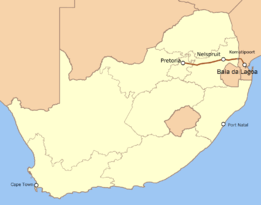
- Ressano Garcia (first stop in Mozambique)
- Moamba
- Lourenço Marques (Maputo since 1975)
- Maputo Bay - (end)
(*) In the above list, only the major settlements on the line are named; the station names are not given.
The line was officially inaugurated on 1 January 1895. Today the line runs through the South African provinces of Gauteng and Mpumalanga. These two provinces, which previously made up the Transvaal Province, contain part of the territory of the former ZAR (along with Limpopo).
After the completion of the Pretoria - Maputo line, a second, much shorter line was laid down between Pretoria and Johannesburg. It adopted the 3 ft 6 in (1,067 mm) of the neighbouring Cape Government Railways.
Other Lines
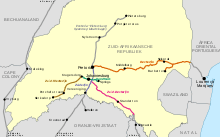
In addition to the Randtram and Pretoria - Delagoa Bay Lines the NZASM operated another 4 lines:[1]
- Kaapmuiden - Barberton, a 55 kilometre (ca. 34 miles) sideline of the Oosterlijn.
- Zuiderlijn (South Line), intended to connect to the Cape Colony via the Orange Free State, ran from Pretoria - Kaalfontein - Zuurfontein - Elandsfontein (Johannesburg) - Vereeniging - Viljoensdrift (border with the Orange Free State). The total line from Pretoria to Cape Town was 1674 kilometres (ca. 1040 miles), of which 125 kilometres (ca. 78 miles) was controlled by the NZASM.
- Zuid-Oosterlijn (Southeast Line), intended to connect to the Natal Colony, ran from Elandsfontein (Johannesburg) - Heidelberg - Standerton - Charleston - Volksrust (border with Natal Colony). The total line from Pretoria to Durban was 812 kilometres (ca. 505 miles), of which 256 kilometres (ca. 160 miles) were part of the Zuid-Oosterlijn.
- Zuid-Westerlijn (Southwest Line), intended to connect to the Orange Free State, ran from Krugersdorp - Potchefstroom - Klerksdorp (border with the Orange Free State) with a length of 156 kilometres (ca. 97 miles).
A 1 kilometre track at Elandsfontein near Johannesburg provided a connection between the Zuiderlijn, the Zuid-Oosterlijn, and the Zuid-Westerlijn.
The South African War to the Present
In 1899 shortly after the outbreak of the South African War, also known as the Second Boer War (1899–1902), the government of the ZAR exercised its rights in accordance to the concession granted to the NZASM to place the company under government control.[9] Towards the end of the war, the company, along with the rail company of the Orange Free State (OVSM), was placed under military control by the British, and in 1904 the NZASM and the OVSM were merged into the Central South African Railways.
After protracted negotiations, NZASM's shareholders and creditors were given some compensation for debts and losses incurred by the company being seized by the British. The NZASM was formally dissolved in 1908, and the final financial statements were presented to shareholders in 1909. The company also published a book, In Memoriam,[1] about the history of the NZASM in 1910. The money from the company's liquidation was used to establish the Zuid-Afrikaansche Stichting Moederland (ZASM) in 1908. The ZASM is an organization dedicated to the advancement of cultural and economic ties between the Netherlands and South Africa. The ZASM also purchased a building in Amsterdam to house the organization's archives and collections, including a part of the NZASM's archives. This building is now used by a variety of organizations under the common banner Zuid-Afrikahuis (South Africa House).
A great deal of the NZASM's infrastructure including bridges, drains, houses, and stations still exists and in many cases is still owned and actively used by Transnet. Several of the NZASM locomotives have survived and now form part of the Outeniqua Transport Museum's collection.
In 1916, shortly after the establishment of the Union of South Africa, the Central South African Railways was merged with the railways of the former English Cape (Cape Government Railways) and Natal (Natal Government Railways) Colonies, resulting in the establishment of the South African Rail and Harbour Administration or Spoornet. In 1980, Spoornet was renamed to Transnet, and it was granted company status in 1990.
.jpg)
The NZASM archives may be found in the South African National Archives in South Africa; the Dutch National Archives in the Netherlands;[10] and in the archives of the Zuid-Afrikahuis[11] and the Dutch Economic History Archive (NEHA),[12][13] both in Amsterdam. The NZASM photos in the collection of the Zuid-Afrikahuis have also been digitized and may be viewed online.[14] NZASM related archival material may also be found in various other archives, including The National Archives of the United Kingdom.
See also
References
- 1 2 3 4 5 6 Nederlandsche Zuid Afrikaansche Spoorweg Maatschappij (1910). In Memoriam N.Z.A.S.M. Amsterdam: J.H. de Bussy.
- ↑ Davis, Clarence; Wilburn, Kenneth (1991). Railway Imperialism. New York: Greenwood Press. pp. 30–33. ISBN 0-313-25966-6.
- ↑ Van Helten, J.-J. (1978). "German Capital, the Netherlands Railway Company and the Political Economy of the Transvaal 1886-1900". Journal of African History. JSTOR 181949.
- 1 2 3 4 5 6 7 8 Holland, D.F. (1971). Steam Locomotives of the South African Railways. 1: 1859–1910 (1st ed.). Newton Abbott, Devon: David & Charles. pp. 109–112. ISBN 978-0-7153-5382-0.
- 1 2 3 4 5 6 Espitalier, T.J.; Day, W.A.J. (1944). The Locomotive in South Africa - A Brief History of Railway Development. Chapter IV - The N.Z.A.S.M.. South African Railways and Harbours Magazine, October 1944. pp. 762, 764.
- 1 2 3 The South African Railways - Historical Survey (Editor George Hart, Publisher Bill Hart, Sponsored by Dorbyl Ltd, Circa 1978.)
- ↑ A South African Railway History
- 1 2 3 Espitalier, T.J.; Day, W.A.J. (1944). The Locomotive in South Africa - A Brief History of Railway Development. Chapter IV - The N.Z.A.S.M. (Continued). South African Railways and Harbours Magazine, November 1944. pp. 843-845, 848.
- ↑ De Jong, R; Van der Waal, G-M; Heydenrych, D (1988). NZASM 100: The Buildings, Steam Engines, and Structures of the Netherlands South African Railway Company. Johannesburg: Chris van Rensburg Publications.
- ↑ "Finding Aid. 2.18.18.02: Inventaris van het archief van de Nederlands-ZuidAfrikaanse Spoorwegmaatschappij (NZASM) te Amsterdam" (PDF). Nationaal Archief. Nationaal Archief, Den Haag. Retrieved 29 April 2016.
- ↑ "Finding Aid. 076: Inventaris van het archief van de Nederlandsch Zuid-Afrikaansche Spoorwegmaatschappij". Zuid-Afrikahuis. Retrieved 29 April 2016.
- ↑ "Collectie Nederlandsch-Zuid-Afrikaansche Spoorwegmaatschappij (Amsterdam)". International Institute for Social History. Retrieved 29 April 2016.
- ↑ "Collectie Nederlandsch-Zuid-Afrikaansche Spoorwegmaatschappij (NZASM)". International Institute of Social History. Retrieved 29 April 2016.
- ↑ "NZASM". Het Geheugen van Nederland. Zuid-Afrikahuis. Retrieved 29 April 2016.
| Wikimedia Commons has media related to Netherlands-South African Railway Company. |